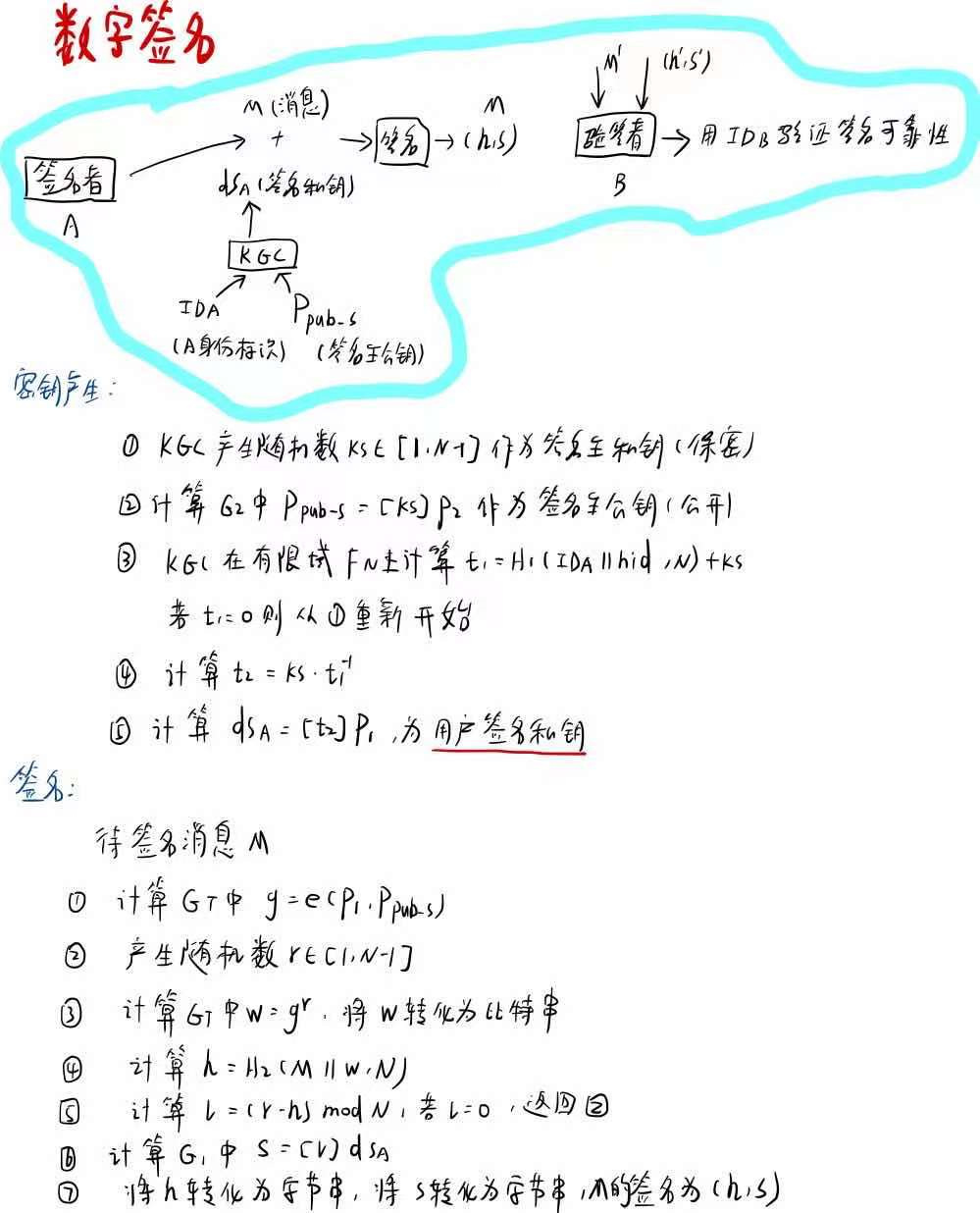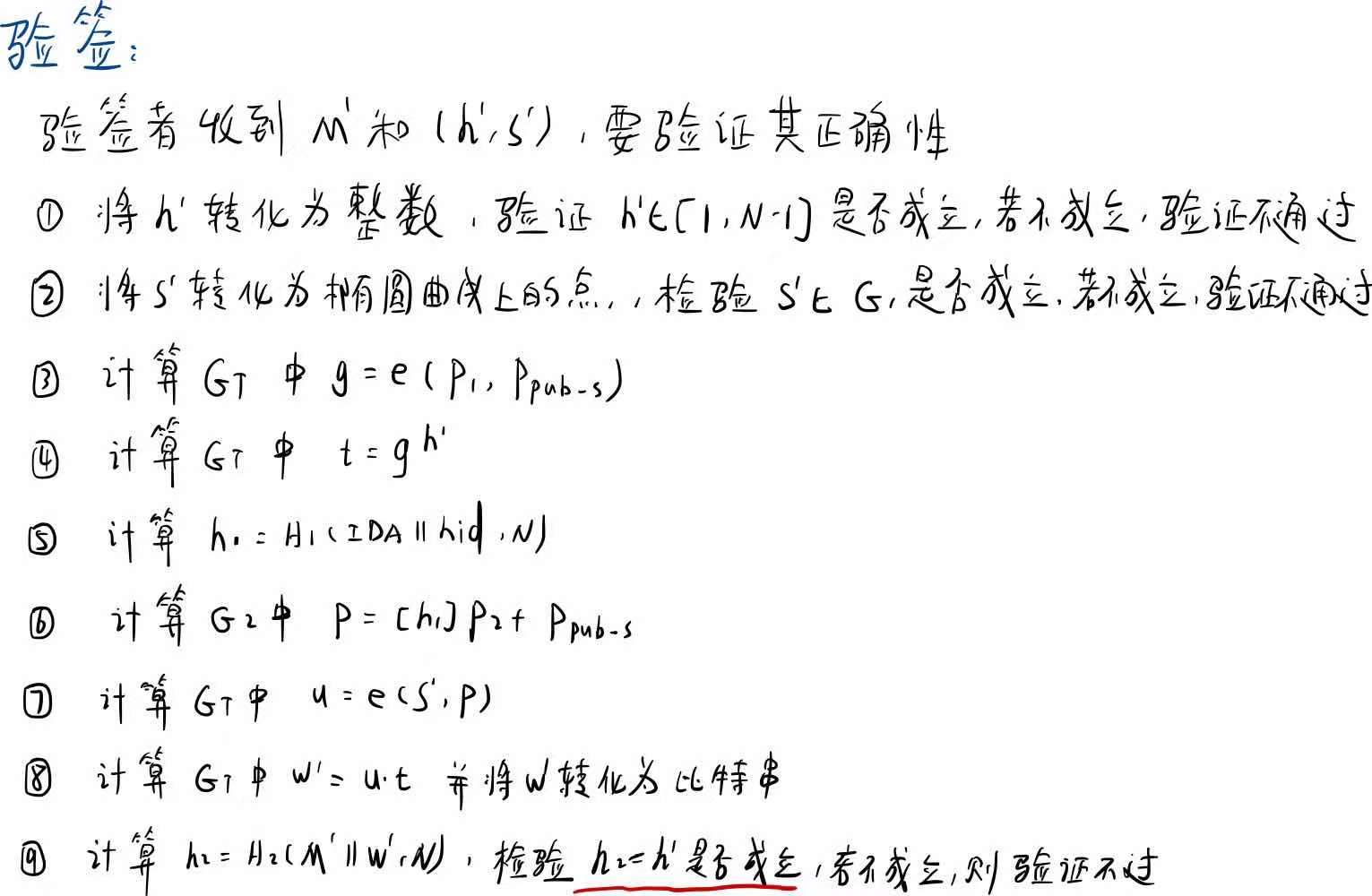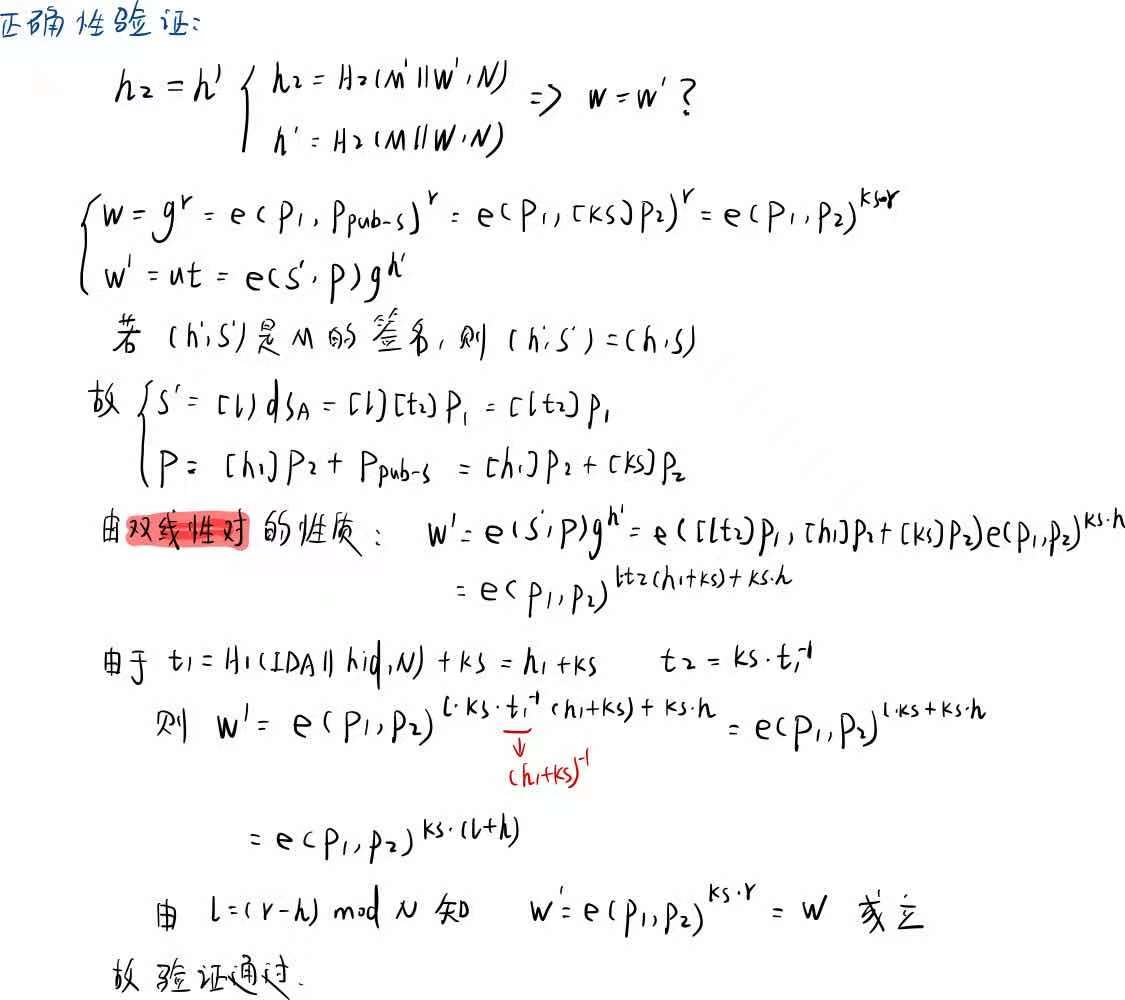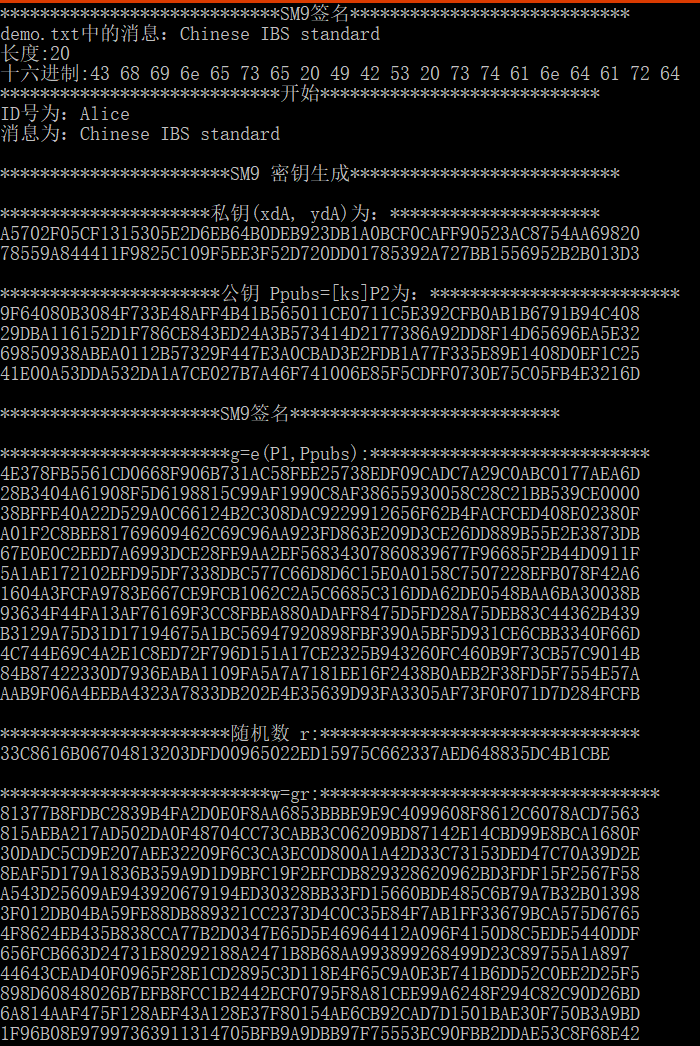SM9-签名
算法过程



代码实现
///************************************************************************
// File name: SM9_sv.c
// Version: SM9_sv_V1.0
// Date: Dec 15,2016
// Description: implementation of SM9 signature algorithm and verification algorithm
// all operations based on BN curve line function
// Function List:
// 1.bytes128_to_ecn2 //convert 128 bytes into ecn2
// 2.zzn12_ElementPrint //print all element of struct zzn12
// 3.ecn2_Bytes128_Print //print 128 bytes of ecn2
// 4.LinkCharZzn12 //link two different types(unsigned char and zzn12)to one(unsigned char)
// 5.Test_Point //test if the given point is on SM9 curve
// 6.Test_Range //test if the big x belong to the range[1,N-1]
// 7.SM9_Init //initiate SM9 curve
// 8.SM9_H1 //function H1 in SM9 standard 5.4.2.2
// 9.SM9_H2 //function H2 in SM9 standard 5.4.2.3
// 10.SM9_GenerateSignKey //generate signed private and public key
// 11.SM9_Sign //SM9 signature algorithm
// 12.SM9_Verify //SM9 verification
// 13.SM9_SelfCheck() //SM9 slef-check //
// Notes:
// This SM9 implementation source code can be used for academic, non-profit making or non-commercial use only.
// This SM9 implementation is created on MIRACL. SM9 implementation source code provider does not provide MIRACL library, MIRACL license or any permission to use MIRACL library. Any commercial use of MIRACL requires a license which may be obtained from Shamus Software Ltd. //**************************************************************************/ #include "SM9_sv.h"
#include "kdf.h" /****************************************************************
Function: bytes128_to_ecn2
Description: convert 128 bytes into ecn2
Calls: MIRACL functions
Called By: SM9_Init
Input: Ppubs[]
Output: ecn2 *res
Return: FALSE: execution error
TRUE: execute correctly
Others:
****************************************************************/
BOOL bytes128_to_ecn2(unsigned char Ppubs[], ecn2 *res)
{
zzn2 x, y;
big a, b;
ecn2 r;
r.x.a = mirvar(0); r.x.b = mirvar(0);
r.y.a = mirvar(0); r.y.b = mirvar(0);
r.z.a = mirvar(0); r.z.b = mirvar(0);
r.marker = MR_EPOINT_INFINITY; x.a = mirvar(0); x.b = mirvar(0);
y.a = mirvar(0); y.b = mirvar(0);
a = mirvar(0); b = mirvar(0); bytes_to_big(BNLEN, Ppubs, b);
bytes_to_big(BNLEN, Ppubs + BNLEN, a);
zzn2_from_bigs(a, b, &x);
bytes_to_big(BNLEN, Ppubs + BNLEN * 2, b);
bytes_to_big(BNLEN, Ppubs + BNLEN * 3, a);
zzn2_from_bigs(a, b, &y); return ecn2_set(&x, &y, res);
} /****************************************************************
Function: zzn12_ElementPrint
Description: print all element of struct zzn12
Calls: MIRACL functions
Called By: SM9_Sign,SM9_Verify
Input: zzn12 x
Output: NULL
Return: NULL
Others:
****************************************************************/
void zzn12_ElementPrint(zzn12 x)
{
big tmp;
tmp = mirvar(0); redc(x.c.b.b, tmp); cotnum(tmp, stdout);
redc(x.c.b.a, tmp); cotnum(tmp, stdout);
redc(x.c.a.b, tmp); cotnum(tmp, stdout);
redc(x.c.a.a, tmp); cotnum(tmp, stdout);
redc(x.b.b.b, tmp); cotnum(tmp, stdout);
redc(x.b.b.a, tmp); cotnum(tmp, stdout);
redc(x.b.a.b, tmp); cotnum(tmp, stdout);
redc(x.b.a.a, tmp); cotnum(tmp, stdout);
redc(x.a.b.b, tmp); cotnum(tmp, stdout);
redc(x.a.b.a, tmp); cotnum(tmp, stdout);
redc(x.a.a.b, tmp); cotnum(tmp, stdout);
redc(x.a.a.a, tmp); cotnum(tmp, stdout);
} /****************************************************************
Function: ecn2_Bytes128_Print
Description: print 128 bytes of ecn2
Calls: MIRACL functions
Called By: SM9_Sign,SM9_Verify
Input: ecn2 x
Output: NULL
Return: NULL
Others:
****************************************************************/
void ecn2_Bytes128_Print(ecn2 x)
{
big tmp;
tmp = mirvar(0); redc(x.x.b, tmp); cotnum(tmp, stdout);
redc(x.x.a, tmp); cotnum(tmp, stdout);
redc(x.y.b, tmp); cotnum(tmp, stdout);
redc(x.y.a, tmp); cotnum(tmp, stdout);
} /****************************************************************
Function: LinkCharZzn12
Description: link two different types(unsigned char and zzn12)to one(unsigned char)
Calls: MIRACL functions
Called By: SM9_Sign,SM9_Verify
Input: message:
len: length of message
w: zzn12 element
Output: Z: the characters array stored message and w
Zlen: length of Z
Return: NULL
Others:
****************************************************************/
void LinkCharZzn12(unsigned char *message, int len, zzn12 w, unsigned char *Z, int Zlen)
{
big tmp; tmp = mirvar(0); memcpy(Z, message, len);
redc(w.c.b.b, tmp); big_to_bytes(BNLEN, tmp, Z + len, 1);
redc(w.c.b.a, tmp); big_to_bytes(BNLEN, tmp, Z + len + BNLEN, 1);
redc(w.c.a.b, tmp); big_to_bytes(BNLEN, tmp, Z + len + BNLEN * 2, 1);
redc(w.c.a.a, tmp); big_to_bytes(BNLEN, tmp, Z + len + BNLEN * 3, 1);
redc(w.b.b.b, tmp); big_to_bytes(BNLEN, tmp, Z + len + BNLEN * 4, 1);
redc(w.b.b.a, tmp); big_to_bytes(BNLEN, tmp, Z + len + BNLEN * 5, 1);
redc(w.b.a.b, tmp); big_to_bytes(BNLEN, tmp, Z + len + BNLEN * 6, 1);
redc(w.b.a.a, tmp); big_to_bytes(BNLEN, tmp, Z + len + BNLEN * 7, 1);
redc(w.a.b.b, tmp); big_to_bytes(BNLEN, tmp, Z + len + BNLEN * 8, 1);
redc(w.a.b.a, tmp); big_to_bytes(BNLEN, tmp, Z + len + BNLEN * 9, 1);
redc(w.a.a.b, tmp); big_to_bytes(BNLEN, tmp, Z + len + BNLEN * 10, 1);
redc(w.a.a.a, tmp); big_to_bytes(BNLEN, tmp, Z + len + BNLEN * 11, 1);
} /****************************************************************
Function: Test_Point
Description: test if the given point is on SM9 curve
Calls:
Called By: SM9_Verify
Input: point
Output: null
Return: 0: success
1: not a valid point on curve Others:
****************************************************************/
int Test_Point(epoint* point)
{
big x, y, x_3, tmp;
epoint *buf; x = mirvar(0); y = mirvar(0);
x_3 = mirvar(0);
tmp = mirvar(0);
buf = epoint_init(); //test if y^2=x^3+b
epoint_get(point, x, y);
power(x, 3, para_q, x_3); //x_3=x^3 mod p
multiply(x, para_a, x);
divide(x, para_q, tmp);
add(x_3, x, x); //x=x^3+ax+b
add(x, para_b, x);
divide(x, para_q, tmp); //x=x^3+ax+b mod p
power(y, 2, para_q, y); //y=y^2 mod p
if (mr_compare(x, y) != 0)
return 1; //test infinity
ecurve_mult(N, point, buf);
if (point_at_infinity(buf) == FALSE)
return 1; return 0;
} /****************************************************************
Function: Test_Range
Description: test if the big x belong to the range[1,n-1]
Calls:
Called By: SM9_Verify
Input: big x ///a miracl data type
Output: null
Return: 0: success
1: x==n,fail
Others:
****************************************************************/
int Test_Range(big x)
{
big one, decr_n; one = mirvar(0);
decr_n = mirvar(0); convert(1, one);
decr(N, 1, decr_n); if ((mr_compare(x, one) < 0) | (mr_compare(x, decr_n)>0))
return 1;
return 0;
} /****************************************************************
Function: SM9_Init
Description: Initiate SM9 curve
Calls: MIRACL functions
Called By: SM9_SelfCheck
Input: null
Output: null
Return: 0: success;
7: base point P1 error
8: base point P2 error
Others:
****************************************************************/
int SM9_Init()
{
big P1_x, P1_y; mip = mirsys(1000, 16);;
mip->IOBASE = 16; para_q = mirvar(0);
N = mirvar(0);
P1_x = mirvar(0);
P1_y = mirvar(0);
para_a = mirvar(0);
para_b = mirvar(0);
para_t = mirvar(0);
X.a = mirvar(0);
X.b = mirvar(0);
P2.x.a = mirvar(0);
P2.x.b = mirvar(0);
P2.y.a = mirvar(0);
P2.y.b = mirvar(0);
P2.z.a = mirvar(0);
P2.z.b = mirvar(0);
P2.marker = MR_EPOINT_INFINITY; P1 = epoint_init();
bytes_to_big(BNLEN, SM9_q, para_q);
bytes_to_big(BNLEN, SM9_P1x, P1_x);
bytes_to_big(BNLEN, SM9_P1y, P1_y);
bytes_to_big(BNLEN, SM9_a, para_a);
bytes_to_big(BNLEN, SM9_b, para_b);
bytes_to_big(BNLEN, SM9_N, N);
bytes_to_big(BNLEN, SM9_t, para_t); mip->TWIST = MR_SEXTIC_M;
ecurve_init(para_a, para_b, para_q, MR_PROJECTIVE); //Initialises GF(q) elliptic curve
//MR_PROJECTIVE specifying projective coordinates if (!epoint_set(P1_x, P1_y, 0, P1))
return SM9_G1BASEPOINT_SET_ERR; if (!(bytes128_to_ecn2(SM9_P2, &P2)))
return SM9_G2BASEPOINT_SET_ERR; set_frobenius_constant(&X); return 0;
} /****************************************************************
Function: SM9_H1
Description: function H1 in SM9 standard 5.4.2.2
Calls: MIRACL functions,SM3_KDF
Called By: SM9_Verify
Input: Z:
Zlen:the length of Z
n:Frobniues constant X
Output: h1=H1(Z,Zlen)
Return: 0: success;
1: asking for memory error
Others:
****************************************************************/
int SM9_H1(unsigned char Z[], int Zlen, big n, big h1)
{
int hlen, i, ZHlen;
big hh, i256, tmp, n1;
unsigned char *ZH = NULL, *ha = NULL; hh = mirvar(0); i256 = mirvar(0);
tmp = mirvar(0); n1 = mirvar(0);
convert(1, i256);
ZHlen = Zlen + 1; hlen = (int)ceil((5.0*logb2(n)) / 32.0);
decr(n, 1, n1);
ZH = (char *)malloc(sizeof(char)*(ZHlen + 1));
if (ZH == NULL) return SM9_ASK_MEMORY_ERR;
memcpy(ZH + 1, Z, Zlen);
ZH[0] = 0x01;
ha = (char *)malloc(sizeof(char)*(hlen + 1));
if (ha == NULL) return SM9_ASK_MEMORY_ERR;
SM3_KDF(ZH, ZHlen, hlen, ha); for (i = hlen - 1; i >= 0; i--)//key[从大到小]
{
premult(i256, ha[i], tmp);
add(hh, tmp, hh);
premult(i256, 256, i256);
divide(i256, n1, tmp);
divide(hh, n1, tmp);
}
incr(hh, 1, h1);
free(ZH); free(ha);
return 0;
}
/****************************************************************
Function: SM9_H2
Description: function H2 in SM9 standard 5.4.2.3
Calls: MIRACL functions,SM3_KDF
Called By: SM9_Sign,SM9_Verify
Input: Z:
Zlen:the length of Z
n:Frobniues constant X
Output: h2=H2(Z,Zlen)
Return: 0: success;
1: asking for memory error
Others:
****************************************************************/
int SM9_H2(unsigned char Z[], int Zlen, big n, big h2)
{
int hlen, ZHlen, i;
big hh, i256, tmp, n1;
unsigned char *ZH = NULL, *ha = NULL; hh = mirvar(0); i256 = mirvar(0);
tmp = mirvar(0); n1 = mirvar(0);
convert(1, i256);
ZHlen = Zlen + 1; hlen = (int)ceil((5.0*logb2(n)) / 32.0);
decr(n, 1, n1);
ZH = (char *)malloc(sizeof(char)*(ZHlen + 1));
if (ZH == NULL) return SM9_ASK_MEMORY_ERR;
memcpy(ZH + 1, Z, Zlen);
ZH[0] = 0x02;
ha = (char *)malloc(sizeof(char)*(hlen + 1));
if (ha == NULL) return SM9_ASK_MEMORY_ERR;
SM3_KDF(ZH, ZHlen, hlen, ha); for (i = hlen - 1; i >= 0; i--)//key[从大到小]
{
premult(i256, ha[i], tmp);
add(hh, tmp, hh);
premult(i256, 256, i256);
divide(i256, n1, tmp);
divide(hh, n1, tmp);
}
incr(hh, 1, h2);
free(ZH); free(ha);
return 0;
} /****************************************************************
Function: SM9_GenerateSignKey
Description: Generate Signed key
Calls: MIRACL functions,SM9_H1,xgcd,ecn2_Bytes128_Print
Called By: SM9_SelfCheck
Input: hid:0x01
ID:identification
IDlen:the length of ID
ks:master private key used to generate signature public key and private key
Output: Ppub:signature public key
dSA: signature private key
Return: 0: success;
1: asking for memory error
Others:
****************************************************************/
int SM9_GenerateSignKey(unsigned char hid[], unsigned char *ID, int IDlen, big ks, unsigned char Ppubs[], unsigned char dsa[])
{
big h1, t1, t2, rem, xdSA, ydSA, tmp;
unsigned char *Z = NULL;
int Zlen = IDlen + 1, buf;
ecn2 Ppub;
epoint *dSA; h1 = mirvar(0); t1 = mirvar(0);
t2 = mirvar(0); rem = mirvar(0); tmp = mirvar(0);
xdSA = mirvar(0); ydSA = mirvar(0);
dSA = epoint_init();
Ppub.x.a = mirvar(0); Ppub.x.b = mirvar(0); Ppub.y.a = mirvar(0); Ppub.y.b = mirvar(0);
Ppub.z.a = mirvar(0); Ppub.z.b = mirvar(0); Ppub.marker = MR_EPOINT_INFINITY; Z = (char *)malloc(sizeof(char)*(Zlen + 1));
memcpy(Z, ID, IDlen);
memcpy(Z + IDlen, hid, 1); buf = SM9_H1(Z, Zlen, N, h1);
if (buf != 0) return buf;
add(h1, ks, t1);//t1=H1(IDA||hid,N)+ks
xgcd(t1, N, t1, t1, t1);//t1=t1(-1)
multiply(ks, t1, t2); divide(t2, N, rem);//t2=ks*t1(-1) //dSA=[t2]P1
ecurve_mult(t2, P1, dSA); //Ppub=[ks]P2
ecn2_copy(&P2, &Ppub);
ecn2_mul(ks, &Ppub); printf("\n*********************私钥(xdA, ydA)为:*********************\n");
epoint_get(dSA, xdSA, ydSA);
cotnum(xdSA, stdout); cotnum(ydSA, stdout);
printf("\n**********************公钥 Ppubs=[ks]P2为:*************************\n");
ecn2_Bytes128_Print(Ppub); epoint_get(dSA, xdSA, ydSA);
big_to_bytes(BNLEN, xdSA, dsa, 1);
big_to_bytes(BNLEN, ydSA, dsa + BNLEN, 1); redc(Ppub.x.b, tmp); big_to_bytes(BNLEN, tmp, Ppubs, 1);
redc(Ppub.x.a, tmp); big_to_bytes(BNLEN, tmp, Ppubs + BNLEN, 1);
redc(Ppub.y.b, tmp); big_to_bytes(BNLEN, tmp, Ppubs + BNLEN * 2, 1);
redc(Ppub.y.a, tmp); big_to_bytes(BNLEN, tmp, Ppubs + BNLEN * 3, 1); free(Z);
return 0;
} /****************************************************************
Function: SM9_Sign
Description: SM9 signature algorithm
Calls: MIRACL functions,zzn12_init(),ecap(),member(),zzn12_ElementPrint(),
zzn12_pow(),LinkCharZzn12(),SM9_H2()
Called By: SM9_SelfCheck()
Input:
hid:0x01
IDA //identification of userA
message //the message to be signed
len //the length of message
rand //a random number K lies in [1,N-1]
dSA //signature private key
Ppubs //signature public key Output: H,S //signature result
Return: 0: success
1: asking for memory error
4: element is out of order q
5: R-ate calculation error
9: parameter L error
Others:
****************************************************************/
int SM9_Sign(unsigned char hid[], unsigned char *IDA, unsigned char *message, int len, unsigned char rand[],
unsigned char dsa[], unsigned char Ppub[], unsigned char H[], unsigned char S[])
{
big h1, r, h, l, xdSA, ydSA;
big xS, yS, tmp, zero;
zzn12 g, w;
epoint *s, *dSA;
ecn2 Ppubs;
int Zlen, buf;
unsigned char *Z = NULL; //initiate
h1 = mirvar(0); r = mirvar(0); h = mirvar(0); l = mirvar(0);
tmp = mirvar(0); zero = mirvar(0);
xS = mirvar(0); yS = mirvar(0);
xdSA = mirvar(0); ydSA = mirvar(0);
s = epoint_init(); dSA = epoint_init();
Ppubs.x.a = mirvar(0);
Ppubs.x.b = mirvar(0);
Ppubs.y.a = mirvar(0);
Ppubs.y.b = mirvar(0);
Ppubs.z.a = mirvar(0);
Ppubs.z.b = mirvar(0);
Ppubs.marker = MR_EPOINT_INFINITY;
zzn12_init(&g); zzn12_init(&w); bytes_to_big(BNLEN, rand, r);
bytes_to_big(BNLEN, dsa, xdSA);
bytes_to_big(BNLEN, dsa + BNLEN, ydSA);
epoint_set(xdSA, ydSA, 0, dSA);
bytes128_to_ecn2(Ppub, &Ppubs); //Step1:g = e(P1, Ppub-s)
if (!ecap(Ppubs, P1, para_t, X, &g))
return SM9_MY_ECAP_12A_ERR;
//test if a ZZn12 element is of order q
if (!member(g, para_t, X))
return SM9_MEMBER_ERR; printf("\n***********************g=e(P1,Ppubs):****************************\n");
zzn12_ElementPrint(g); //Step2:calculate w=g(r)
printf("\n***********************随机数 r:********************************\n");
cotnum(r, stdout);
w = zzn12_pow(g, r);
printf("\n***************************w=gr:**********************************\n");
zzn12_ElementPrint(w); //Step3:calculate h=H2(M||w,N)
Zlen = len + 32 * 12;
Z = (char *)malloc(sizeof(char)*(Zlen + 1));
if (Z == NULL)
return SM9_ASK_MEMORY_ERR; LinkCharZzn12(message, len, w, Z, Zlen);
buf = SM9_H2(Z, Zlen, N, h);
if (buf != 0)
return buf;
printf("\n****************************h:*************************************\n");
cotnum(h, stdout); //Step4:l=(r-h)mod N
subtract(r, h, l);
divide(l, N, tmp);
while (mr_compare(l, zero)<0)
add(l, N, l);
if (mr_compare(l, zero) == 0)
return SM9_L_error;
printf("\n**************************l=(r-h)mod N:****************************\n");
cotnum(l, stdout); //Step5:S=[l]dSA=(xS,yS)
ecurve_mult(l, dSA, s);
epoint_get(s, xS, yS);
printf("\n**************************S=[l]dSA=(xS,yS):*************************\n");
cotnum(xS, stdout); cotnum(yS, stdout); big_to_bytes(32, h, H, 1);
big_to_bytes(32, xS, S, 1);
big_to_bytes(32, yS, S + 32, 1); free(Z);
return 0;
}
/****************************************************************
Function: SM9_Verify
Description: SM9 signature verification algorithm
Calls: MIRACL functions,zzn12_init(),Test_Range(),Test_Point(),
ecap(),member(),zzn12_ElementPrint(),SM9_H1(),SM9_H2()
Called By: SM9_SelfCheck()
Input:
H,S //signature result used to be verified
hid //identification
IDA //identification of userA
message //the message to be signed
len //the length of message
Ppubs //signature public key Output: NULL
Return: 0: success
1: asking for memory error
2: H is not in the range[1,N-1]
6: S is not on the SM9 curve
4: element is out of order q
5: R-ate calculation error
3: h2!=h,comparison error
Others:
****************************************************************/
int SM9_Verify(unsigned char H[], unsigned char S[], unsigned char hid[], unsigned char *IDA, unsigned char *message, int len,
unsigned char Ppub[])
{
big h, xS, yS, h1, h2;
epoint *S1;
zzn12 g, t, u, w;
ecn2 P, Ppubs;
int Zlen1, Zlen2, buf;
unsigned char * Z1 = NULL, *Z2 = NULL; h = mirvar(0);
h1 = mirvar(0);
h2 = mirvar(0);
xS = mirvar(0);
yS = mirvar(0);
P.x.a = mirvar(0);
P.x.b = mirvar(0);
P.y.a = mirvar(0);
P.y.b = mirvar(0);
P.z.a = mirvar(0);
P.z.b = mirvar(0);
P.marker = MR_EPOINT_INFINITY;
Ppubs.x.a = mirvar(0);
Ppubs.x.b = mirvar(0);
Ppubs.y.a = mirvar(0);
Ppubs.y.b = mirvar(0);
Ppubs.z.a = mirvar(0);
Ppubs.z.b = mirvar(0);
Ppubs.marker = MR_EPOINT_INFINITY;
S1 = epoint_init();
zzn12_init(&g), zzn12_init(&t);
zzn12_init(&u); zzn12_init(&w); bytes_to_big(BNLEN, H, h);
bytes_to_big(BNLEN, S, xS);
bytes_to_big(BNLEN, S + BNLEN, yS);
bytes128_to_ecn2(Ppub, &Ppubs); //Step 1:test if h in the rangge [1,N-1]
if (Test_Range(h))
return SM9_H_OUTRANGE; //Step 2:test if S is on G1
epoint_set(xS, yS, 0, S1);
if (Test_Point(S1))
return SM9_S_NOT_VALID_G1; //Step3:g = e(P1, Ppub-s)
if (!ecap(Ppubs, P1, para_t, X, &g))
return SM9_MY_ECAP_12A_ERR;
//test if a ZZn12 element is of order q
if (!member(g, para_t, X))
return SM9_MEMBER_ERR; printf("\n***********************g=e(P1,Ppubs):****************************\n");
zzn12_ElementPrint(g); //Step4:calculate t=g(h)
t = zzn12_pow(g, h);
printf("\n***************************w=gh:**********************************\n");
zzn12_ElementPrint(t); //Step5:calculate h1=H1(IDA||hid,N)
Zlen1 = strlen(IDA) + 1;
Z1 = (char *)malloc(sizeof(char)*(Zlen1 + 1));
if (Z1 == NULL) return SM9_ASK_MEMORY_ERR; memcpy(Z1, IDA, strlen(IDA));
memcpy(Z1 + strlen(IDA), hid, 1);
buf = SM9_H1(Z1, Zlen1, N, h1);
if (buf != 0) return buf;
printf("\n****************************h1:**********************************\n");
cotnum(h1, stdout); //Step6:P=[h1]P2+Ppubs
ecn2_copy(&P2, &P);
ecn2_mul(h1, &P);
ecn2_add(&Ppubs, &P); //Step7:u=e(S1,P)
if (!ecap(P, S1, para_t, X, &u)) return SM9_MY_ECAP_12A_ERR;
//test if a ZZn12 element is of order q
if (!member(u, para_t, X)) return SM9_MEMBER_ERR;
printf("\n************************** u=e(S1,P):*****************************\n");
zzn12_ElementPrint(u); //Step8:w=u*t
zzn12_mul(u, t, &w);
printf("\n************************* w=u*t: **********************************\n");
zzn12_ElementPrint(w); //Step9:h2=H2(M||w,N)
Zlen2 = len + 32 * 12;
Z2 = (char *)malloc(sizeof(char)*(Zlen2 + 1));
if (Z2 == NULL)
return SM9_ASK_MEMORY_ERR; LinkCharZzn12(message, len, w, Z2, Zlen2);
buf = SM9_H2(Z2, Zlen2, N, h2);
if (buf != 0) return buf;
printf("\n**************************** h2:***********************************\n");
cotnum(h2, stdout); free(Z1);
free(Z2); printf("\n签名验证结果:\n");
if (mr_compare(h2, h) != 0)
{
printf("h 不等于 h2,验证失败!\n");
return SM9_DATA_MEMCMP_ERR;
}
else
printf("h 等于 h2,验证成功!\n\n"); return 0;
} /****************************************************************
Function: SM9_SelfCheck
Description: SM9 self check
Calls: MIRACL functions,SM9_Init(),SM9_GenerateSignKey(),
SM9_Sign,SM9_Verify
Called By:
Input: 要签名的字符串
Output:
Return: 0: self-check success
1: asking for memory error
2: H is not in the range[1,N-1]
3: h2!=h,comparison error
4: element is out of order q
5: R-ate calculation error
6: S is not on the SM9 curve
7: base point P1 error
8: base point P2 error
9: parameter L error
A: public key generated error
B: private key generated error
C: signature result error
Others:
****************************************************************/
int SM9_SelfCheck(unsigned char *message)
{
//the master private key
unsigned char dA[32] = { 0x00,0x01,0x30,0xE7,0x84,0x59,0xD7,0x85,0x45,0xCB,0x54,0xC5,0x87,0xE0,0x2C,0xF4,
0x80,0xCE,0x0B,0x66,0x34,0x0F,0x31,0x9F,0x34,0x8A,0x1D,0x5B,0x1F,0x2D,0xC5,0xF4 }; unsigned char rand[32] = { 0x00,0x03,0x3C,0x86,0x16,0xB0,0x67,0x04,0x81,0x32,0x03,0xDF,0xD0,0x09,0x65,0x02,
0x2E,0xD1,0x59,0x75,0xC6,0x62,0x33,0x7A,0xED,0x64,0x88,0x35,0xDC,0x4B,0x1C,0xBE }; unsigned char h[32], S[64];// Signature
unsigned char Ppub[128], dSA[64]; //提前算好的对于预设签名字符串“Chinese IBS standard”的签名值
//作用:签名后会验证h和std_h,S和std_S,若得到的签名值与这两个算好的不同,则说明签名出错
unsigned char std_h[32] = { 0x82,0x3C,0x4B,0x21,0xE4,0xBD,0x2D,0xFE,0x1E,0xD9,0x2C,0x60,0x66,0x53,0xE9,0x96,
0x66,0x85,0x63,0x15,0x2F,0xC3,0x3F,0x55,0xD7,0xBF,0xBB,0x9B,0xD9,0x70,0x5A,0xDB };
unsigned char std_S[64] = { 0x73,0xBF,0x96,0x92,0x3C,0xE5,0x8B,0x6A,0xD0,0xE1,0x3E,0x96,0x43,0xA4,0x06,0xD8,
0xEB,0x98,0x41,0x7C,0x50,0xEF,0x1B,0x29,0xCE,0xF9,0xAD,0xB4,0x8B,0x6D,0x59,0x8C,
0x85,0x67,0x12,0xF1,0xC2,0xE0,0x96,0x8A,0xB7,0x76,0x9F,0x42,0xA9,0x95,0x86,0xAE,
0xD1,0x39,0xD5,0xB8,0xB3,0xE1,0x58,0x91,0x82,0x7C,0xC2,0xAC,0xED,0x9B,0xAA,0x05 };
unsigned char std_Ppub[128] = { 0x9F,0x64,0x08,0x0B,0x30,0x84,0xF7,0x33,0xE4,0x8A,0xFF,0x4B,0x41,0xB5,0x65,0x01,
0x1C,0xE0,0x71,0x1C,0x5E,0x39,0x2C,0xFB,0x0A,0xB1,0xB6,0x79,0x1B,0x94,0xC4,0x08,
0x29,0xDB,0xA1,0x16,0x15,0x2D,0x1F,0x78,0x6C,0xE8,0x43,0xED,0x24,0xA3,0xB5,0x73,
0x41,0x4D,0x21,0x77,0x38,0x6A,0x92,0xDD,0x8F,0x14,0xD6,0x56,0x96,0xEA,0x5E,0x32,
0x69,0x85,0x09,0x38,0xAB,0xEA,0x01,0x12,0xB5,0x73,0x29,0xF4,0x47,0xE3,0xA0,0xCB,
0xAD,0x3E,0x2F,0xDB,0x1A,0x77,0xF3,0x35,0xE8,0x9E,0x14,0x08,0xD0,0xEF,0x1C,0x25,
0x41,0xE0,0x0A,0x53,0xDD,0xA5,0x32,0xDA,0x1A,0x7C,0xE0,0x27,0xB7,0xA4,0x6F,0x74,
0x10,0x06,0xE8,0x5F,0x5C,0xDF,0xF0,0x73,0x0E,0x75,0xC0,0x5F,0xB4,0xE3,0x21,0x6D };
unsigned char
std_dSA[64] = { 0xA5,0x70,0x2F,0x05,0xCF,0x13,0x15,0x30,0x5E,0x2D,0x6E,0xB6,0x4B,0x0D,0xEB,0x92,
0x3D,0xB1,0xA0,0xBC,0xF0,0xCA,0xFF,0x90,0x52,0x3A,0xC8,0x75,0x4A,0xA6,0x98,0x20,
0x78,0x55,0x9A,0x84,0x44,0x11,0xF9,0x82,0x5C,0x10,0x9F,0x5E,0xE3,0xF5,0x2D,0x72,
0x0D,0xD0,0x17,0x85,0x39,0x2A,0x72,0x7B,0xB1,0x55,0x69,0x52,0xB2,0xB0,0x13,0xD3 }; unsigned char hid[] = { 0x01 };
unsigned char *IDA = "Alice";
//unsigned char *message = "Chinese IBS standard";//the message to be signed
//unsigned char *message = "SM9 Identity-based cryptographic algorithms";
int mlen = strlen(message), tmp;//the length of message
big ks; printf("ID号为:%s\n",IDA);
printf("消息为:%s\n", message); tmp = SM9_Init(); if (tmp != 0) return tmp;
ks = mirvar(0); bytes_to_big(32, dA, ks); printf("\n***********************SM9 密钥生成***************************\n");
tmp = SM9_GenerateSignKey(hid, IDA, strlen(IDA), ks, Ppub, dSA);
if (tmp != 0)
return tmp;
if (memcmp(Ppub, std_Ppub, 128) != 0)
return SM9_GEPUB_ERR;
if (memcmp(dSA, std_dSA, 64) != 0)
return SM9_GEPRI_ERR; printf("\n**********************SM9签名***************************\n");
tmp = SM9_Sign(hid, IDA, message, mlen, rand, dSA, Ppub, h, S);
if (tmp != 0) return tmp; //此两句为验证签名值与预设字符串“Chinese IBS standard”得到的签名值是否相同
//若从外界输入签名字符串或文件,则注释掉即可
/*
if (memcmp(h, std_h, 32) != 0)
return SM9_SIGN_ERR;
if (memcmp(S, std_S, 64) != 0) //为何消息一改动,此处就会返回SM9_SIGN_ERR?
return SM9_SIGN_ERR;
*/
printf("\n*******************SM9签名验证*************************\n");
tmp=SM9_Verify(h, S, hid, IDA, message, mlen, Ppub);
if (tmp != 0) return tmp; return 0;
}

全部代码见github
参考
1、国标—SM9-签名
2、密码学-基础理论与应用(李子臣著)
3、商用密码检测中心-源码下载
SM9-签名的更多相关文章
- Linux实现树莓派3B的国密SM9算法交叉编译——(三)国密SM9算法实现
先参考这篇文章 Linux实现树莓派3B的国密SM9算法交叉编译——(二)miracl库的测试与静态库的生成 进行miracl库的交叉编译测试,并生成miracl静态链接库. 这篇文章主要介绍基于mi ...
- 阿里签名中URLEncode于C#URLEncod不同之处
问题 如上图所示,阿里云的PercentEncode 转换! 为 %21 PercentEncode 源码为: package com.aliyuncs.auth; import java.io.Un ...
- Gradle配置APK自动签名完整流程
转载请注明出处:http://www.cnblogs.com/LT5505/p/6256683.html 一.生成签名 1.命令行生成签名,输入命令keytool -genkey -v -keysto ...
- WebApi基于Token和签名的验证
最近一段时间在学习WebApi,涉及到验证部分的一些知识觉得自己并不是太懂,所以来博客园看了几篇博文,发现一篇讲的特别好的,读了几遍茅塞顿开(都闪开,我要装逼了),刚开始读有些地方不理解,所以想了很久 ...
- NodeJs支付宝移动支付签名及验签
非常感谢 :http://www.jianshu.com/p/8513e995ff3a?utm_campaign=hugo&utm_medium=reader_share&utm_co ...
- Windows Server 2008 R2 下配置TLS1.2,添加自签名证书
前言 2017年1月1日起App Store上的所有App应用将强制开启ATS功能. 苹果的ATS(App Transport Security)对服务器硬性3点要求: ① ATS要求TLS1.2或者 ...
- Java 程序的打包、签名和验证
参考资料 该文中的内容来源于 Oracle 的官方文档.Oracle 在 Java 方面的文档是非常完善的.对 Java 8 感兴趣的朋友,可以直接找到这个总入口 Java SE 8 Document ...
- C#制作、打包、签名、发布Activex全过程
一.前言 最近有这样一个需求,需要在网页上面启动客户端的软件,软件之间的通信.调用,单单依靠HTML是无法实现了,因此必须借用Activex来实现.由于本人主要擅长C#,自然本文给出了用C#实现的范例 ...
- 【Win10应用开发】签名与验证
对数据进行签名和验证,是为了防止数据被“盗版”.比较常规的做法是通过公钥进行验证. 算法上多用SAH_xxxx,就是哈希算法.由于MD5后来被发现存在“非唯一性”,你会发现现在很多一些下载的文件验证都 ...
- 如何写出安全的API接口?接口参数加密签名设计思路
开发中经常用到接口,尤其是在面向服务的soa架构中,数据交互全是用的接口. 几年以前我认为,我写个接口,不向任何人告知我的接口地址,我的接口就是安全的,现在回想真是too young,too simp ...
随机推荐
- macos安装Charles
一.安装jdk 1.地址:https://www.oracle.com/cn/java/technologies/downloads/#java11,下载后双击安装 2.查看java的安装地址,在ma ...
- TAMAYA
TAMAYA 挺有意思的维护题. 题面 n个小夫坐成一排,每个小夫有一个真实值vi.小夫们有m场聚会,第i次聚会会在编号为 [li, ri] 的小夫中举办. 聚会之后,这些小夫的真实值会变为他们之中的 ...
- P10681 COTS/CETS 2024 奇偶矩阵 Tablica
P10681 COTS/CETS 2024 奇偶矩阵 Tablica 来自 qnqfff 大佬的梦幻 dp. 约定 二元组 \((n,m)\) 表示一个 \(n\) 行 \(m\) 列的矩形. 不添加 ...
- P8392 BalticOI 2022 Day1 Uplifting Excursion
P8392 BalticOI 2022 Day1 Uplifting Excursion 贪心加动规,好题,这两个甚至完全相反的东西可以融进一道题-- 思路 物品较少,贡献较小,体积较小,但总体积巨大 ...
- CritiCS:智能协作下的创意长篇故事生成框架 | EMNLP'24
来源:晓飞的算法工程笔记 公众号,转载请注明出处 论文: Collective Critics for Creative Story Generation 论文地址:https://arxiv.org ...
- Java 并发编程实战学习笔记——寻找可强化的并行性
寻找可强化的并行性 1.串行执行所有任务 代码 复制 - 运行 package net.jcip.examples; import java.util.*; /** * SingleThreadRen ...
- js逆向之常用算法
[Python] encode & decode from urllib import parse # url进行编码与解码 url = '你好啊' url_encode = parse.qu ...
- vue composition api 访问 原vue2中 this.$refs
1 <el-form class="user-form" ref="ruleFormRef" :model="userForm" st ...
- 如何在 duxapp 中开发一个兼容 RN 的动画库
Taro 一直以来都没有一个能兼容 RN 的动画方案,duxapp 中扩展了 createAnimation 方法,让这个方法兼容了 RN 端,下面让我们来看看实现思路 createAnimation ...
- N皇后问题(DFS-深度优先算法)
N皇后问题(DFS-深度优先算法) 题目描述: 在 N×N 的方格棋盘放置了 N 个皇后,使得它们不相互攻击(即任意 22 个皇后不允许处在同一排,同一列,也不允许处在与棋盘边框成 45° 的斜线上. ...
